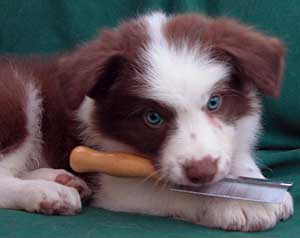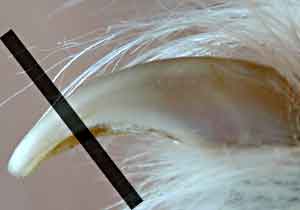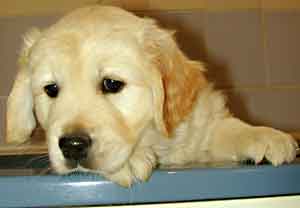Bringing up Puppy
Examining and Grooming

Grooming should be a pleasure
for you and your dog
Your puppy will need grooming throughout his life.
Grooming stimulates the skin, lifts out dead hair and allows you to examine your dog for cuts, bruises, and parasites such as ticks, fleas and lice.
Grooming also has an important social dimension for dogs.
In a pack the top-dog will, when he pleases, groom another dog lower in the hierarchy. This behaviour reinforces the top-dog's authority and comforts and soothes the under-dog.
When you groom your puppy you are reminding him, in the nicest possible way, that you are not only his superior but also a trustworthy leader who cares about him and takes responsible for his safety and well being.
Some puppies, if they are a little assertive, will resist grooming because they do not like to be submissive, in this case you should hold the puppy firmly but gently and make him lie still whilst you groom him all over.
Grooming is as much about social status within the pack as about hygiene and you will not be able train a puppy that will not allow you to groom him.
Examining
Before you groom your puppy examine him thoroughly.
Start at the head and check the mouth for damage to teeth or other injuries, examine each eye for signs of infection or irritation.
Lift each ear flap and check that the ear smells sweet, never probe into your puppy's ear but get him used to feeling you finger at the opening to the ear canal so that if he ever needs to have his ears examined by a vet he will sit still and not resist.
Check his neck and back for cuts, bruises, stings or bites.
Roll him on his back and for each foot in turn, put your fingers gently in between the pads and check the webbing for injury or grass seeds.
Look at the nails to see if they need clipping.
Whilst your puppy is on his back check for mats of hair under is armpits.
Examine your puppy's rear end checking for mats of hair in his knickers.
If your puppy is a bitch, once she is 6 months old you will need to be checked regularly to see whether she has come into season, if your puppy is a dog check for any signs of infection.
Examine your puppy's tail for mats or injury.
This should be a bonding and relaxing experience for you and your puppy, if the puppy is in a household of several people it is a good idea that they all take turns in examining and grooming the puppy.
Grooming
Use a good quality human hairbrush to groom your puppy.
Natural bristle is best and will not damage your puppy's coat.
Never forget to brush your puppy's back end, tail and around his ears, these are areas where mats most readily form.
Mats are tight clumps of dead hair which have been left in the coat and are tangled up with the live hairs. If you find a mat in your puppy's coat try to gently tease it out but if you cannot remove it without causing your puppy discomfort cut it out very carefully with blunt nosed scissors.
Regular and frequent grooming will prevent mats from forming. Once you have brushed through your puppy's coat you may wish to comb using a steel comb with quite widely spaced teeth to tease out any dead hair or dead undercoat.
Finish by giving a gentle but vigorous brush to bring up the shine.
Dental Hygiene
Most dogs, as they get older suffer from tooth decay. Often an elderly dog has to be subjected to a general anesthetic for an operation to clean his teeth because the level of decay has become so severe.
It is possible for dogs to have good teeth all their lives if a regular routine of dental care is followed.
Your young puppy will still have his (very sharp) milk teeth to begin with and although these will be shed in favour of his adult teeth by the time he is 6-7 months old he is never too young to learn to have his teeth brushed.
Your vet will recommend an appropriate toothbrush and dental gel for your puppy and as soon as possible you should introduce your puppy to the idea of having his mouth carefully touched and examined, remember to be especially gentle when your puppy is teething.
Because your puppy's mouth will be too small to for a toothbrush to begin with, you can put a little gel onto your finger and just introduce your puppy to the experience. Some dental hygiene gels do not need to be brushed onto the teeth but can be spread onto a treat or kibble of food.
Good quality chew toys are available which are designed
to help clean your puppy's teeth and large raw marrow bones are excellent
for keeping teeth clean but never give any cooked bones or small, sharp,
raw bones to your dog or puppy.
Nail
Trimming

this claw is too long for comfort,
the line shows where it should be cut
Dogs which are regularly given good walks on hard surfaces such as pavements or roads will naturally wear down their nails and trimming may never be necessary.
Puppies are not subject to such rigorous exercise and their nails will very quickly grow too long unless they spend much of their time on concrete or other hard surfaces.
You may wish to ask your vet to trim your puppy's nails when they get too long or you may wish to do so your self.
A dog's nail is similar to a human finger nail in that only the very tip needs to be trimmed, imagine having your whole finger nail cut off including the top of your finger!
With a small puppy a sharp, strong pair of scissors will be adequate to trim the tip of the nail although in an older puppy or dog proper clippers are necessary.
Remember to trim just the white chalky (or black) tip of the nail, there is a blood vessel extending down the nail which shows up pink in good light, you must not cut this or it will hurt the puppy and bleed profusely.
If you are in any doubt get your vet to trim puppy's nail and ask your vet to show you how to do so too.
Bathing

Puppies should get used to being bathed
Your puppy should get used to the idea of a bath so that, when he is fully-grown and he needs a bath he does not become overexcited or frightened by the experience - besides this, puppies can be messy little creatures and are generally much more appealing when clean.
Always groom your puppy before you bath him otherwise any tangles in his coat will tighten up and cause matting.
Make sure that the water is warm but never hot or you may frighten or hurt your puppy.
Use a good quality shampoo, which does not irritate the eyes, and use a good conditioner on the puppy's tail and knickers to make him easier to brush afterwards.
Never bath your puppy on a cold day unless he is
to stay in the warm until he is completely dry and never let your puppy
go to bed damp.
When a bitch has finished her season you should give
her a good bath to get rid of any scent which may attract unwelcome attention
from male dogs.
|
|||||||||||||||||
|